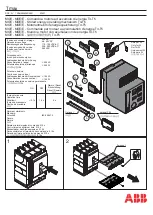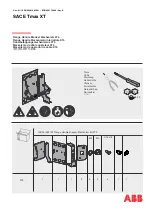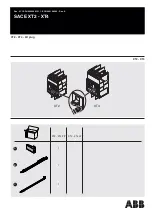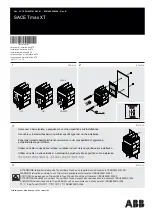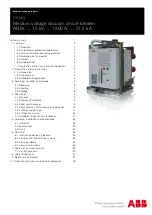
IB 6.2.11.1-1C
Page 20
ABB
1. Either disable the trip elements not being tested or
set them to their highest threshold value.
2. It is recommended that the Range Selection be set
to its lowest value to minimize the current required for
this test; however, it may be set to either available
value.
3. Set the Long Time threshold. Set the delay to its
minimum value.
4. Test for the actual threshold by increasing test
current until the Self Monitor light begins to blink
quickly. The breaker should trip about 8-13 seconds
later.
5. The threshold tolerance is +/- 10% on all selector
switch settings.
Long-Time Delay Test
1. Position other trip element selectors at their highest
threshold value.
2. It is recommended that the Range Selection be set
to its lowest value to minimize the current required for
this test; however, it may be set to either available
value.
3. Set the Long Time threshold to its maximum setting.
4. Set test current so that it represents three times (3X)
the trip system Range Selection setting. Delays should
be as shown in Figure 12.
Short-Time Delay Test
1. Position other trip element selectors at their highest
threshold value.
2. It is recommended that the Range Selection be set
to its lowest value to minimize the current required for
this test; however, it may be set to either available
value.
6. These procedures are written for primary injection. If
the trip device is being tested by secondary current
injection, use a special test cable available from ABB
and follow the special instructions contained therewith.
7. The term “Range Selection” is used herein for
consistency with previous MPS-type devices, and
refers to the value of the “Rating” setting of the device.
Like the previous MPS-type devices, the MPSC-2000 is
capable of operating at two basic ratings: one equal to
the maximum frame continuous current rating and one
equal to one-half the frame rating. For example, on an
800A breaker, the MPSC-2000 rating can be set to
800A or 400A. When the rating is changed, other
available settings are scaled accordingly; thus the term
“Range Selection”.
Instantaneous or Short Time Threshold Test
1. Either disable the trip elements not being tested, or
set them to their highest threshold value. Set the Long
Time Delay to its maximum setting. Set the Short Time
delay to its minimum setting for Short Time tests.
2. It is recommended that the Range Selection be set
to its lowest value to minimize the current required for
this test; however, it may be set to either available
value.
3. Set the threshold and delay of the trip element being
tested (again, it is recommended that a low value be
used).
4. Test for the actual threshold by increasing test
current until the breaker trips. It is important to
increase the current fast enough so that the breaker will
not be tripped by the Long Time element prior to
completion of the test.
5. The threshold tolerance is +/- 10% on all selector
switch settings.
Long-Time Threshold Test
Figure 12. Trip Element Delay Times
Delay Times (sec.)
Trip Element
Min.
Int.
Max
Long Time
8-13
20-33
61-100
Short Time (DEF)
0.080-0.170
0.200-0.320
0.350-0.500
Short Time (IIT)
0.160-0.250
0.520-0.780
0.910-1.350
Ground Trip (IIT) (200A-800A Sensors)
0.68-1.3
2.1-4.2
5.2-9.5
Ground Trip (IIT) (1600A-2000A Sensors)
0.07-0.18
0.24-0.47
0.59-1.2

































